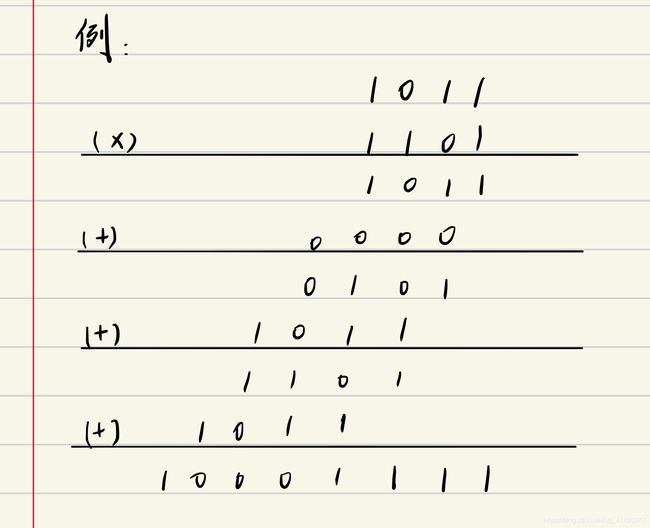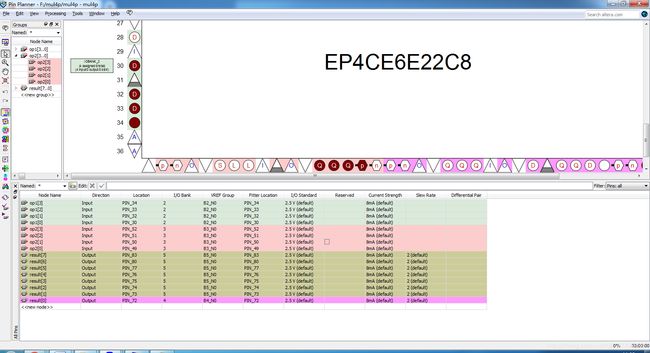Quartus II 实验 (二)——VHDL 4位加法器和4位乘法器
0x1 前言
计算机组成原理实验项目要求之一,使用Quartus II的VHDL语言制作一个 4位加法器和4位乘法器,并烧到试验箱中进行测试。
关于我所使用的试验箱DICE-E213的部分介绍请参照 Quartus II 实验 (一)——软件和试验箱DICE-E213的基本说明
0x2 四位乘法器
- 首先说明目录结构:
|
|-- and4a
|-- ls283
|-- mul4p
- 二进制加法过程
- 模块说明
- and4a 乘法模块,负责将 每一位乘数 与 被乘数 相乘
- ls283 加法模块,负责将中间结果相加。
>>> 需要特别注意的是上述每一个都是一个工程,完成以后需要进行编译;在主程序中需要将上面两个模块引入,才能正常调用。
-
and4a
Library ieee;
Use ieee.std_logic_1164.all;
Use ieee.std_logic_unsigned.all;
Entity and4a is
Port(a:in std_logic_vector(3 downto 0);
en:in std_logic;
r:out std_logic_vector(3 downto 0));
End and4a;
Architecture behave of and4a is
Begin
Process(en,a(3 downto 0))
Begin
If (en='1') then
r<=a;
Else
r<="0000";
End if;
End process;
End behave;
-
ls283
Library ieee;
Use ieee.std_logic_1164.all;
Use ieee.std_logic_unsigned.all;
Entity ls283 is
Port (o1,o2:in std_logic_vector(3 downto 0);
res:out std_logic_vector(4 downto 0));
End ls283;
Architecture behave of ls283 is
Begin
Process(o1,o2)
Begin
res<=('0'&o1)+('0'&o2);
End process;
End behave;
-
mul4p
这部分是主程序
Library ieee;
Use ieee.std_logic_1164.all;
Use ieee.std_logic_unsigned.all;
Entity mul4p is
Port (op1,op2:in std_logic_vector(3 downto 0);
result:out std_logic_vector(7 downto 0));
End mul4p;
Architecture count of mul4p is
component and4a port (a:in std_logic_vector(3 downto 0);
en:in std_logic;
r:out std_logic_vector(3 downto 0));
End component;
Component ls283 port (o1,o2:in std_logic_vector(3 downto 0);
res:out std_logic_vector(4 downto 0));
End component;
Signal sa:std_logic_vector(3 downto 0);
Signal sb:std_logic_vector(4 downto 0);
Signal sc:std_logic_vector(3 downto 0);
Signal sd:std_logic_vector(4 downto 0);
Signal se:std_logic_vector(3 downto 0);
Signal sf:std_logic_vector(3 downto 0);
Signal sg:std_logic_vector(3 downto 0);
--signal tmp1:std_logic;
Begin
sg<=('0'&sf (3 downto 1));
--tmp1<=op1(1);
u0:and4a port map(a=>op2,en=>op1(1),r=>se);
U1:and4a port map(a=>op2,en=>op1(3),r=>sa);
U2:ls283 port map(o1=>sb(4 downto 1),o2=>sa,res=>result(7 downto 3));
U3:and4a port map(a=>op2,en=>op1(2),r=>sc);
U4:ls283 port map(o1=>sc,o2=>sd(4 downto 1),res=>sb);
u5:ls283 port map(o1=>sg,o2=>se,res=>sd);
u6:and4a port map(a=>op2,en=>op1(0),r=>sf);
result(0)<=sf(0);
result(1)<=sd(0);
result(2)<=sb(0);
--result(7 downto 0)<="00000000";
End count;
将上面两个模块引入主程序工程的方法是:
如图所示将另外两个工程的文件夹引入主程序工程。
编译!
-
上电!烧进实验箱
这个过程不在赘述,过程中如出现问题,可以参考 Quartus II 实验 (一)——软件和试验箱DICE-E213的基本说明
- 自定义引脚如图所示:
- 试验箱引脚组参考图(试验箱参考文档):
参照上图不难看出,我使用的引脚组是
输入1:JP3(2,4,5,6)
输入2:JP4(3,4,5,6)
输出:JP6(1,2,3,4,5,6,7,8)
测试之前说说明一下:对于本实验箱:按钮输入的一组:按下0弹出1,对于推动开关输入的一组:推上1推下0,输出灯泡:亮0灭1。
测试试验箱的流程在有 Quartus II 实验 (一)——软件和试验箱DICE-E213的基本说明 详细介绍。
-
测试
此时上排按钮表示1111,下派开关输入量为0000,结果0000 0000 灯全亮。
此时上排1111,下排1111,结果应为225 即 11100001
此时上排1000,下排1100,结果应为3,即 0000 0011
当上排按钮全部按下,上排0000,无论下派为何值,结果都为0000
-
结果正确,实验结束!
0x3四位加法器
操作和乘法器一样,不再赘述。
只做一点简要说明:
结构:halfadd-->fulladd-->adder4
贴出代码
- halfadd
Library ieee;
Use ieee.std_logic_1164.all;
Entity halfadd is
Port(a,b:in std_logic;
S,c:out std_logic);
end halfadd;
Architecture add of halfadd is
begin
S<=a xor b;
c<=a and b;
end;- fulladd
Library ieee;
Use ieee.std_logic_1164.all;
Entity fulladd is
Port(a,b,cin:in std_logic;
S,c:out std_logic);
end fulladd;
Architecture add of fulladd is
signal m,n,k:std_logic;
component halfadd is
Port(a,b:in std_logic;
S,c:out std_logic);
end component;
begin
U0:halfadd port map(a,b,m,n);
U1:halfadd port map(m,cin,S,k);
c<=n or k;
end;- adder4
Library ieee;
Use ieee.std_logic_1164.all;
Entity adder4 is
Port(a,b:in std_logic_vector(3 downto 0);
cin:in std_logic;
S:out std_logic_vector(3 downto 0);
co:out std_logic);
end adder4;
Architecture add of adder4 is
signal c:std_logic_vector(3 downto 0);
component fulladd is
Port(a,b,cin:in std_logic;
S,c:out std_logic);
end component;
begin
U0:fulladd port map(a(0),b(0),cin,S(0),c(0));
U1:fulladd port map(a(1),b(1),c(0),S(1),c(1));
U2:fulladd port map(a(2),b(2),c(1),S(2),c(2));
U3:fulladd port map(a(3),b(3),c(2),S(3),co);
end;最后说一点:工程路径不能有中文。
0x4 在此给出两份文件供大家参考
VHDL 4位加法器 VHDL 4位乘法器 http://sudo.ys168.com/ 公共下载区
备用链接:https://download.csdn.net/download/qq_41420747/11248001
在试验过程中如有错误,欢迎留言,讨论,也欢迎指出我的错误。





